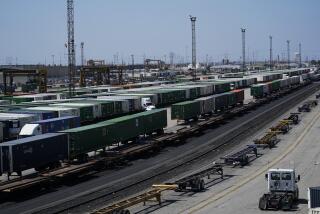Derailed coal train fuels critics of increased Northwest shipping
A derailed Spokane-bound train interrupted an interstate railroad thoroughfare for more than 24 hours, but the tracks were to reopen Tuesday night, BNSF Railway Co. officials said.
The freight train derailed Monday, spewing 31 cars and tons of coal dust across the arid grasslands of southeast Washington.
More than 50 workers from a nearby town bulldozed 30 of the 31 cars into a heap, righted the last one, and cleared the tracks, officials said.
The derailment remains under investigation, but it provides fodder for opponents of a proposed increase in coal shipping in the Pacific Northwest.
“If we see a tremendous increase in coal trains, we’ll see a tremendous increase in derailments,” Brett VandenHeuvel, executive director of a local river preservation organization, told the Los Angeles Times. “It’s that simple.”
The rail lines in the Pacific Northwest are some of the most heavily trafficked in the world. The BNSF route, which angles northeast from Portland to Spokane, is the only rail cut-through in the Cascade Mountains. It is also the only rail route to the Powder River Basin, a 20,000-acre area in Wyoming that produces nearly 40% of the nation’s coal.
But that single rail route wouldn’t be enough to supply Asia, a market coveted by coal companies. Six proposals for new coal shipping terminals in Washington and Oregon are in the environmental analysis stage. Multiple federal agencies have asked the U.S. Army Corps of Engineers to review the effects the terminals would have on the Powder River Basin.
Should those proposals go through, train traffic in southeastern Washington would increase from three trains a day to more than 30, VandenHeuvel said, putting an enormous strain on towns, vineyards and farms.
More train traffic would mean more environmental issues – including coal dust, which can contribute to derailments.
“Coal dust poses a serious threat to the stability of the track structure and … to the operational integrity of our lines in the Powder River Basin,” BNSF says in a statement on its website.
After a multiyear investigation, BNSF found that coal dust buildup can prevent water from draining out of the tracks, leading to flooding, warping and sometimes derailment.
The company told shippers in 2010 to limit coal dust their shipments shed, but left how to do that to the shippers. The BNSF spokeswoman who answers questions about coal could not be reached for comment.
Up to 500 pounds of coal dust can blow off during a shipment, said Kimberly Larson, a spokeswoman for the environmental nonprofit ClimateSolutions. Much of that occurs near the mines, but also can blow off further along the route.
Along the Columbia River, not far from the train tracks, VandenHeuvel said he sometimes finds pea-size lumps of coal littering the riverbank.
ALSO:
Forest Service chief: July 4 brings additional fire risks
‘Andy Griffith’ tune: Most recognizable theme song of all time?
Electric prod used on horses at Reno Rodeo; group claims coverup
Follow Laura on Twitter. Email: laura.nelson@latimes.com.
More to Read
Sign up for Essential California
The most important California stories and recommendations in your inbox every morning.
You may occasionally receive promotional content from the Los Angeles Times.











